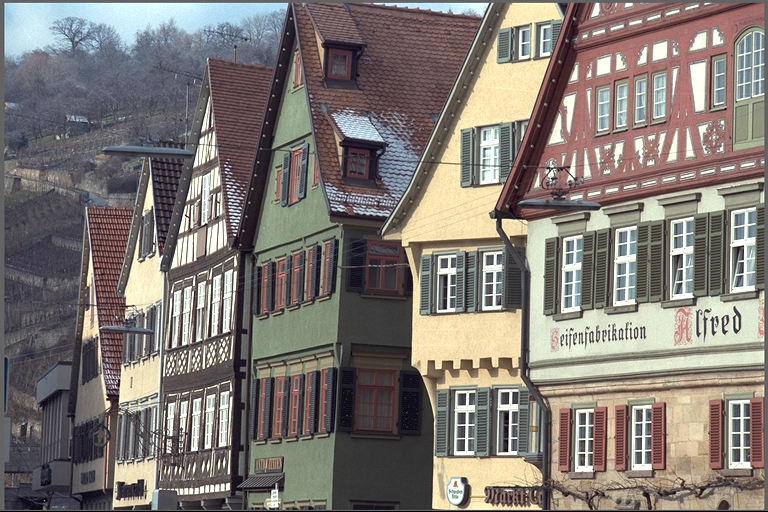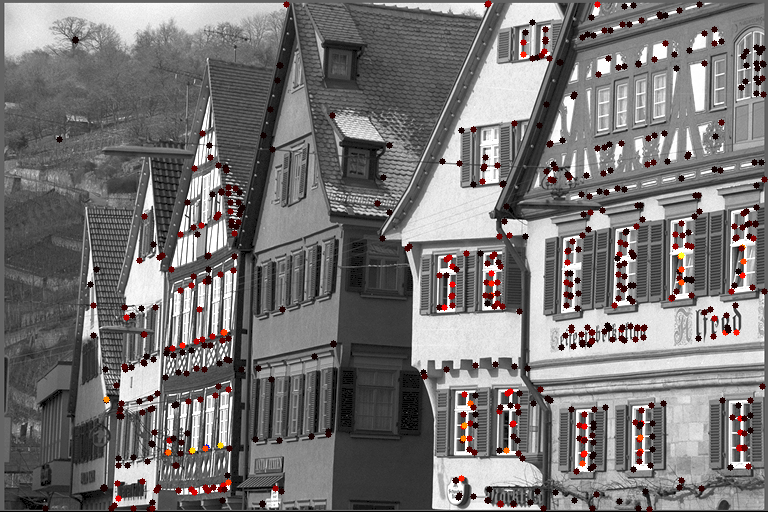Harris Corners Detector
Overview
This application detects Harris corners from a given input image. The corners are then drawn onto the input image and the result is saved to harris.png.
This sample shows the following VPI features:
- Creating and destroying a VPI device.
- Wrapping an image hosted on CPU (the input) to be used by VPI.
- Creating a VPI-managed 1D array where corners output will be written to.
- Create a properly-configured Harris algorithm and submit it to the device.
- Simple device synchronization.
- Array locking to access its contents from CPU side.
- Error handling.
- Environment clean up.
Instructions
The usage is:
./vpi_sample_03_harris_keypoints <backend> <input image>
where
- backend: either cpu, cuda or pva; it defines the backend that will perform the processing.
- input image: input image file name, it accepts png, jpeg and possibly others.
Once the sample is built, you can run it with the following command:
./vpi_sample_03_harris_keypoints pva ../assets/kodim08.png
This is using the PVA backend and one of the provided sample images. You can try with other input images, respecting the constraints imposed by the algorithm. If your device doesn't support PVA, an error is printed. In this case, just try another backend.
Source Code
For convenience, here's the code that is also installed in the samples directory.
/*
* Copyright (c) 2019, NVIDIA CORPORATION. All rights reserved.
*
* Redistribution and use in source and binary forms, with or without
* modification, are permitted provided that the following conditions
* are met:
* * Redistributions of source code must retain the above copyright
* notice, this list of conditions and the following disclaimer.
* * Redistributions in binary form must reproduce the above copyright
* notice, this list of conditions and the following disclaimer in the
* documentation and/or other materials provided with the distribution.
* * Neither the name of NVIDIA CORPORATION nor the names of its
* contributors may be used to endorse or promote products derived
* from this software without specific prior written permission.
*
* THIS SOFTWARE IS PROVIDED BY THE COPYRIGHT HOLDERS ``AS IS'' AND ANY
* EXPRESS OR IMPLIED WARRANTIES, INCLUDING, BUT NOT LIMITED TO, THE
* IMPLIED WARRANTIES OF MERCHANTABILITY AND FITNESS FOR A PARTICULAR
* PURPOSE ARE DISCLAIMED. IN NO EVENT SHALL THE COPYRIGHT OWNER OR
* CONTRIBUTORS BE LIABLE FOR ANY DIRECT, INDIRECT, INCIDENTAL, SPECIAL,
* EXEMPLARY, OR CONSEQUENTIAL DAMAGES (INCLUDING, BUT NOT LIMITED TO,
* PROCUREMENT OF SUBSTITUTE GOODS OR SERVICES; LOSS OF USE, DATA, OR
* PROFITS; OR BUSINESS INTERRUPTION) HOWEVER CAUSED AND ON ANY THEORY
* OF LIABILITY, WHETHER IN CONTRACT, STRICT LIABILITY, OR TORT
* (INCLUDING NEGLIGENCE OR OTHERWISE) ARISING IN ANY WAY OUT OF THE USE
* OF THIS SOFTWARE, EVEN IF ADVISED OF THE POSSIBILITY OF SUCH DAMAGE.
*/
#include <vpi/Array.h>
#include <vpi/Image.h>
#include <vpi/Stream.h>
#include <vpi/algo/HarrisKeypointDetector.h>
#include <cstring> // for memset
#include <iostream>
#include <opencv2/imgcodecs.hpp>
#include <opencv2/imgproc.hpp>
#define CHECK_STATUS(STMT) \
do \
{ \
VPIStatus status = (STMT); \
if (status != VPI_SUCCESS) \
{ \
throw std::runtime_error(vpiStatusGetName(status)); \
} \
} while (0);
{
cv::Mat out;
img.convertTo(out, CV_8UC1);
cvtColor(out, out, cv::COLOR_GRAY2BGR);
if (numKeypoints == 0)
{
return out;
}
// prepare our colormap
cv::Mat cmap(1, 255, CV_8UC3);
{
cv::Mat gray(1, 255, CV_8UC1);
for (int i = 0; i < 255; ++i)
{
gray.at<unsigned char>(0, i) = i;
}
applyColorMap(gray, cmap, cv::COLORMAP_HOT);
}
float maxScore = *std::max_element(scores, scores + numKeypoints);
for (int i = 0; i < numKeypoints; ++i)
{
cv::Vec3b color = cmap.at<cv::Vec3b>(scores[i] / maxScore * 255);
circle(out, cv::Point(kpts[i].x, kpts[i].y), 3, cv::Scalar(color[0], color[1], color[2]), -1);
}
return out;
}
int main(int argc, char *argv[])
{
VPIImage image = nullptr;
VPIArray keypoints = nullptr;
VPIArray scores = nullptr;
VPIStream stream = nullptr;
VPIPayload harris = nullptr;
int retval = 0;
try
{
if (argc != 3)
{
throw std::runtime_error(std::string("Usage: ") + argv[0] + " <cpu|pva|cuda> <input image>");
}
std::string strDevType = argv[1];
std::string strInputFileName = argv[2];
// Load the input image
cv::Mat cvImage = cv::imread(strInputFileName, cv::IMREAD_GRAYSCALE);
if (cvImage.empty())
{
throw std::runtime_error("Can't open '" + strInputFileName + "'");
}
// Currently we only accept signed 16bpp
cvImage.convertTo(cvImage, CV_16SC1);
// Now process the device type
VPIDeviceType devType;
if(strDevType == "cpu")
{
devType = VPI_DEVICE_TYPE_CPU;
}
else if(strDevType == "cuda")
{
devType = VPI_DEVICE_TYPE_CUDA;
}
else if(strDevType == "pva")
{
devType = VPI_DEVICE_TYPE_PVA;
}
else
{
throw std::runtime_error("Backend '" + strDevType + "' not recognized, it must be either cpu, cuda or pva.");
}
// Create the stream for the given backend.
CHECK_STATUS(vpiStreamCreate(devType, &stream));
// We now wrap the loaded image into a VPIImage object to be used by VPI.
{
// First fill VPIImageData with the, well, image data...
VPIImageData imgData;
memset(&imgData, 0, sizeof(imgData));
imgData.type = VPI_IMAGE_TYPE_Y16I;
imgData.numPlanes = 1;
// Wrap it into a VPIImage. VPI won't make a copy of it, so the original
// image must be in scope at all times.
CHECK_STATUS(vpiImageWrapHostMem(&imgData, 0, &image));
}
// Create the output keypoint array. Currently for PVA backend it must have 8192 elements.
CHECK_STATUS(vpiArrayCreate(8192, VPI_ARRAY_TYPE_KEYPOINT, 0, &keypoints));
// Create the output scores array. It also must have 8192 elements and elements must be uint32_t.
CHECK_STATUS(vpiArrayCreate(8192, VPI_ARRAY_TYPE_U32, 0, &scores));
// Create the payload for Harris Corners Detector algorithm
CHECK_STATUS(vpiCreateHarrisKeypointDetector(stream, cvImage.cols, cvImage.rows, &harris));
// Submit it for processing passing the inputs and outputs.
{
VPIHarrisKeypointDetectorParams params;
params.gradientSize = 5;
params.blockSize = 5;
params.strengthThresh = 250;
params.sensitivity = 0.24;
params.minNMSDistance = 8; // must be 8 for PVA backend
CHECK_STATUS(vpiSubmitHarrisKeypointDetector(harris, image, keypoints, scores, ¶ms));
}
// Wait until the algorithm finishes processing
CHECK_STATUS(vpiStreamSync(stream));
// Now let's retrieve the output
{
// Lock output keypoints and scores to retrieve its data on cpu memory
VPIArrayData outKeypointsData;
VPIArrayData outScoresData;
CHECK_STATUS(vpiArrayLock(keypoints, VPI_LOCK_READ, &outKeypointsData));
CHECK_STATUS(vpiArrayLock(scores, VPI_LOCK_READ, &outScoresData));
uint32_t *outScores = (uint32_t *)outScoresData.data;
printf("%d keypoints found\n", outKeypointsData.size);
cv::Mat outImage = DrawKeypoints(cvImage, outKeypoints, outScores, outKeypointsData.size);
imwrite("harris_keypoints_"+strDevType+".png", outImage);
// Done handling outputs, don't forget to unlock them.
CHECK_STATUS(vpiArrayUnlock(scores));
CHECK_STATUS(vpiArrayUnlock(keypoints));
}
}
catch (std::exception &e)
{
std::cerr << e.what() << std::endl;
retval = 1;
}
// Clean up
vpiImageDestroy(image);
vpiArrayDestroy(keypoints);
vpiArrayDestroy(scores);
vpiPayloadDestroy(harris);
vpiStreamDestroy(stream);
return retval;
}
Results
| Input image | Output image, Harris keypoints |
|---|---|
 |  |